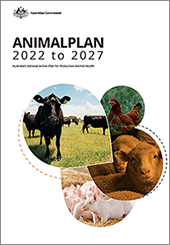Animalplan 2022 to 2027 is Australia’s first national action plan for production animal health. It aims to strengthen animal health practices in our livestock industries.
Animalplan has 7 objectives that were developed through extensive engagement with government, industry organisations and animal health experts. It was endorsed by the Minister for Agriculture, Fisheries and Forestry, and by state and territory agriculture ministers, in September 2022.
The plan consolidates themes from over 30 existing strategies, action plans and frameworks. This includes the Commonwealth Biosecurity 2030 roadmap and the National Biosecurity Strategy.
Animalplan 2022 to 2027
Animalplan is Australia’s first national action plan for production animal health.
If you have difficulty accessing these files, contact us for help.
Animalplan Steering Committee
Find out about the Animalplan Steering Committee.
Animalplan Secretariat
Find out more about the Animalplan Secretariat and how to submit a new project.
Webinars
Find out more about Animalplan projects and activities in our Webinar series.
Animalplan projects
The project database includes information that was previously available in the Animalplan progress reports published between November 2023 and February 2025. Visit the Animalplan Secretariat page for information on submitting a new project.

